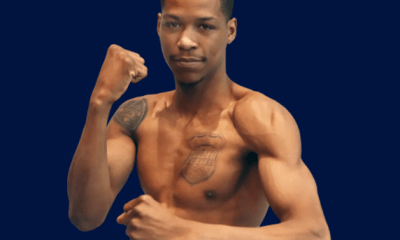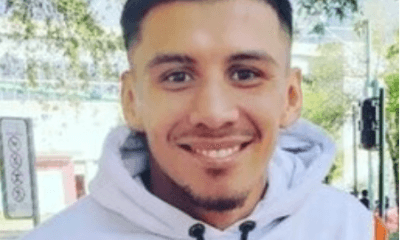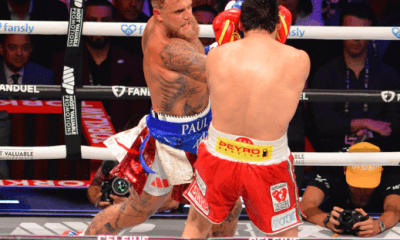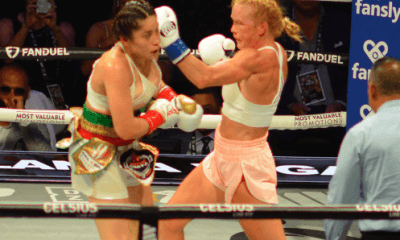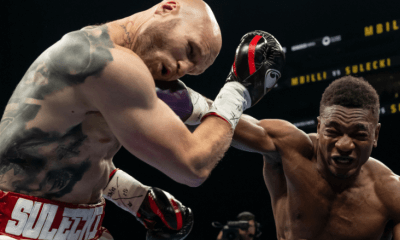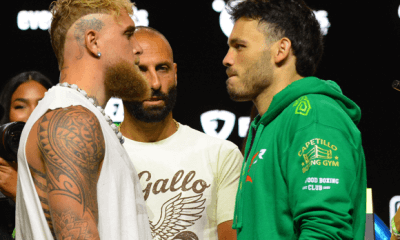Featured Articles
There Was a Smorgasbord of Tasty Delights in Dueling TV Fight Cards
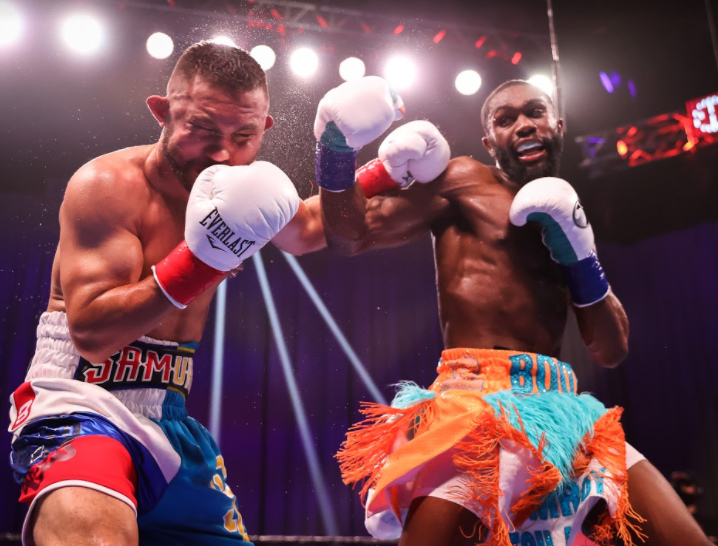
Technology has not advanced to the point where someone can actually be in two places at the same time, but until that happens, the next best thing is the wonderful consolation prize of being able to watch one fight card live on television while recording the other for delayed perusal.
Maybe there can be too much of a good thing sometimes. If I were in a position where I had to make a choice to physically be in attendance at one site or another on Saturday night, it would have been difficult choosing between being there to witness Philadelphia’s emerging welterweight sensation, Jaron “Boots” Ennis, put on another spectacular show in dispatching former junior welter world champion Sergey Lipinets in the Showtime-televised main event in Uncasville, Conn., or another gritty performance by blue-collar, working-class hero Joe Smith Jr. as he finally won a world light heavyweight title with a hard-fought, typically inelegant and somewhat controversial majority decision over Russia’s Maxim Vlasov in the ESPN/ESPN+ card-topper at the Osage Casino in Tulsa, Okla.
In and of themselves, the two featured bouts, so different in execution and outcome but each compelling in their own way, would have satisfied most fight fans. But like a buffet line where diners can snack on tasty hors d’oeuvres –type fare before loading their plates with a preferred entrée item, each card offered additional value by way of televised undercard bouts.
The most dominant performance, and the one of highest potential value moving forward? That would be still another star-making turn by the 23-year-old Ennis (27-0, 25 KOs), who did pretty much whatever he wanted in becoming the first fighter to knock out Lipinets (16-2-1, 12 KOs), the 32-year-old former IBF junior welterweight titlist who had gone the distance with Mikey Garcia and had never been decked as a professional until he went down twice against Boots, who looks like he has the goods to soon take his place in the pantheon of outstanding fighters to represent the city of his birth.
OK, so the first ruled knockdown by referee Arthur Mercante Jr., which came in the fourth round, likely was an error of judgment as replays showed that Lipinets actually tripped on Ennis’ foot. But there was no mistaking what happened in the sixth round, when Ennis, who had been casually teeing off on the stocky Russian as if he were just another heavy bag to be pounded on in the gym, caught Lipinets with a right hook followed by a left uppercut. Lipinets went down flat onto his back, and Mercante immediately waved the massacre off, dispensing with the formality of initiating a count.
The ending meant that Ennis still had not been extended beyond the sixth round as a pro, but this relatively swift termination of a bout whose outcome seemed predetermined from the outset was more significant given Lipinets’ reputation as a tough, durable former champ who had never been so outclassed in matchups with other top-shelf performers. If Ennis hadn’t already stamped himself as a force to be reckoned with in the 147-pound weight class, his domination of Lipinets sent that message out loud and clear.
“Another special fighter from Philadelphia. Imagine that,” said Showtime blow-by-blow announcer Mauro Ranallo.
“More Boots Ennis,” studio host Brian Custer said when asked what he wanted next. “This kid is spectacular. Say his name. Jaron `Boots’ Ennis is going to be a problem in the welterweight division.”
What wasn’t there to like? Ennis has a smorgasbord of ring skills that would be difficult for even other elite 147-pounders to solve. He switches from orthodox to southpaw as fluidly and effectively as does arguably the top pound-for-pound fighter in the world, Terence “Bud” Crawford (37-0, 28 KOs), the WBO welterweight ruler. He occasionally employed the shoulder roll that was a staple of the great Floyd Mayweather Jr., and his penchant for finishing off his man when he has him in trouble pretty much is beyond dispute at this stage of a career whose best days might yet come.
According to CompuBox statistics, Ennis landed a ridiculously high percentage of his power shots (91 of 172, 52.9%), going to the body frequently as part of a well-thought-out strategy crafted by his father-trainer, Derrick “Bozy” Ennis. His next fight may well be against the formidable Yordenis Ugas (26-4, 12 KOs), a Miami-based Cuban, but by now it doesn’t seem much of a stretch to imagine him giving the welterweight division’s crème de la crème, Crawford and WBC/IBF titlist Errol Spence Jr. (27-0, 21 KOs) all they could handle. Perhaps Ennis would benefit from a bit more seasoning against higher-tier opponents, but if his time isn’t exactly right now, that time is fast approaching.
“I was just in there, having fun, doing me,” Ennis said of his unhurried but quite thorough thrashing of Lipinets. “You know, being real relaxed and putting on a show … I just coasted, I took my time and I broke him down.”
Joe Smith Jr. MD12 Maxim Vlasov
The backstory of Joe Smith Jr. – a card-carrying member of Local 66 from Long Island, N.Y., who spends his days pouring concrete, digging trenches, laying sheetrock, power-washing septic tanks and knocking down walls with a sledgehammer, and his nights training as a light heavyweight contender with a dream of making it all the way to a world title – always have been a bit more intriguing than what his limited skill-set has been able to produce inside the ropes.
This 31-year-old Everyman with a most common name is tough, determined and a dangerous puncher, but all that will carry him only so far now that he finally has that bejeweled belt (as winner of the vacant WBO 175-pound championship) he so long has coveted, by virtue of his hardly clear-cut majority decision over the unorthodox Russian Maxim Vlasov. Seemingly behind through 10 rounds, a bloodied and perhaps desperate Smith reached deep inside himself to win the last two rounds, drawing even on my unofficial, watching-at-home scorecard at six rounds apiece. He fared better with the judges in Tulsa, however, with David Sutherland joining me in seeing the fight as a 114-114 standoff, a determination overruled by the cards submitted by Gerald Ritter (115-112) and Pat Russell (115-113).
Presumably next up for Smith is a unification showdown with WBC/IBF ruler Artur Beterbiev (16-0, 16 KOs), the Canada-based Russian who is an even bigger puncher than Smith and is widely regarded as the best light heavyweight on the planet. Such a bout likely would mean a career-high payday for the newly wed Smith, but just as likely the end of his brief reign as an alphabet titlist.
“I want other belts,” Smith, who fought from the first round on with a worrisome cut above his left eye. “I want the big fights out there. I believe I’m going to start unifying belts.”
Finally the favorite – Smith (27-3, 21 KOs) had made his reputation on his inside-the-distance upsets of Andrzej Fonfara and nearly 52-year-old Bernard Hopkins – the easy-to-like Everyman’s coronation proved to be no easy task as Vlasov (45-4, 26 KOs) confused him in the early going with an unorthodox style that had him delivering punches from odd angles.
But Smith is difficult to discourage, and he kept pressing his attack in the hope he could find an opening to deliver the kind of put-away shot that had vanquished Fonfara and B-Hop. He got in some wicked licks, too, several times hurting Vlasov, who bled from the mouth from the seventh round on.
The 11th round was perhaps pivotal, as Vlasov went down, clearly from a punch. But referee Gary Ritter ruled that the delivered blow was an illegal rabbit punch, and he waved off the knockdown and gave Vlasov additional time to recover.
“I believe that round where I hurt him, he stuck his head down (and into the disputed punch),” Smith said. “I should have got the knockdown on that. I think I would have got the stoppage that round, but he pulled it off and made it out on his feet.”
It also could have been that, not getting credit for the knockdown, which conceivably might have opened the door to a knockout or a TKO, made Smith – who originally was to have fought Vlasov on Feb. 13, a date postponed when the Russian tested positive for COVID-19 – fight even harder the rest of the way. CompuBox listed him as landing a career-high 174 power shots, 68 coming in the last two rounds that he so clearly needed.
Whatever viewers might have thought of the decision, Smith-Vlasov was entertaining and competitive.
Efe Ajagba KO3 Brian Howard
Ajagba, a 26-year-old Nigerian, delivered one of the most emphatic one-punch knockouts of the year when he landed a jolting overhand right to the left ear of Howard, who went down in a heap, unconscious, his legs twisted beneath him. Referee Tony Crebs signaled the end of the fight immediately.
It was the second fight for the 6’6” Ajagba, who signed with Top Rank in August 2020, with his new support team of manager James Prince and trainer Kay Koroma. Whether he has bettered his circumstances for those changes (he previously was with Richard Schaefer’s Ringstar Sports, and worked with manager Shelly Finkel and trainer Ronnie Shields) is a matter of conjecture, but the promise – and punching power — he had exhibited beforehand seems to have remained intact.
“It’s my time to shine,” Ajagba said. “I’m coming for the heavyweights to become heavyweight champion of the world.”
He could get his shot, and maybe more quickly now that he is with Top Rank, which promotes the WBC titlist, Tyson Fury (30-0-1, 21 KOs), with a full unification matchup with WBA/IBF/WBO champ Anthony Joshua (24-1, 22 KOs) close to being finalized.
Nigeria has a history for producing good fighters, the most renowned being the late former middleweight and light heavyweight champion, Dick Tiger, an enshrinee into the International Boxing Hall of Fame. The best Nigerian heavyweight likely was Ike Ibeabuchi, who might have been good enough to win a world title had it not been for mental and legal issues that landed him in prison. It remains to be seen if Ajagba can match or surpass Ibeabuchi, but he would appear to have a reasonable chance of doing so in comparison to Samuel Peter, Henry Akinwande, David Izonritei and Duncan Dokiwari.
“Efe Ajagba is one of the most gifted young heavyweights I’ve seen in quite some time,” Arum said when he signed him. “He has immense physical tools and a great work ethic. I have the utmost confidence that we’re looking at a future heavyweight champion.”
The two televised lead-ins to Ennis-Lipinets were IBF junior bantamweight champion Jerwin Ancajas’ unanimous decision over Jonathan Rodriguez and rising welterweight Eimantas Stanionis’ UD12 over former world title challenger Thomas Dulorme.
Jerwin Ancajas UD12 Jonathan Rodriguez
Ancajas (33-1-2, 22 KOs), who years ago drew the attention of fellow Filipino Manny Pacquiao, retained his title for the ninth time against mandatory challenger Rodriguez (22-2, 16 KOs) of Mexico, who was decked for the first time in his pro career in round eight.
Eimantas Stanionis UD 12 Thomas Dulorme
Stanionis (13-0, 9 KOs), from Lithuania, could eventually become a factor in the loaded welterweight division. He certainly didn’t do himself any harm with his win over tough Puerto Rican Dulorme (25-5-1, 16 KOs).
Photo credit: Amanda Westcott / SHOWTIME
Check out more boxing news on video at the Boxing Channel
To comment on this story in the Fight Forum CLICK HERE
-

 Featured Articles3 weeks ago
Featured Articles3 weeks agoAvila Perspective, Chap. 330: Matchroom in New York plus the Latest on Canelo-Crawford
-

 Featured Articles2 weeks ago
Featured Articles2 weeks agoVito Mielnicki Jr Whitewashes Kamil Gardzielik Before the Home Folks in Newark
-
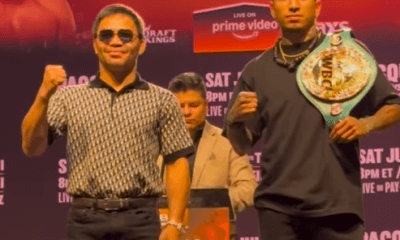
 Featured Articles4 weeks ago
Featured Articles4 weeks agoAvila Perspective, Chap 329: Pacquiao is Back, Fabio in England and More
-
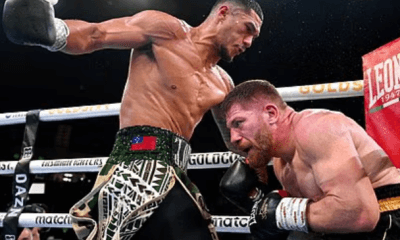
 Featured Articles3 weeks ago
Featured Articles3 weeks agoOpetaia and Nakatani Crush Overmatched Foes, Capping Off a Wild Boxing Weekend
-

 Featured Articles2 weeks ago
Featured Articles2 weeks agoCatching Up with Clay Moyle Who Talks About His Massive Collection of Boxing Books
-

 Featured Articles4 weeks ago
Featured Articles4 weeks agoFabio Wardley Comes from Behind to KO Justis Huni
-

 Featured Articles1 week ago
Featured Articles1 week agoMore Medals for Hawaii’s Patricio Family at the USA Boxing Summer Festival
-
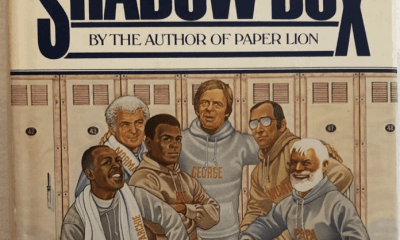
 Featured Articles4 weeks ago
Featured Articles4 weeks agoDelving into ‘Hoopla’ with Notes on Books by George Plimpton and Joyce Carol Oates

